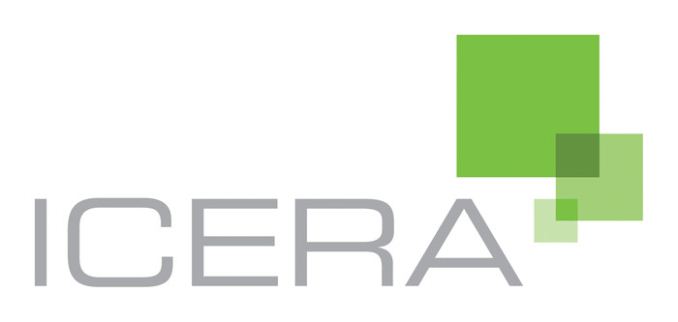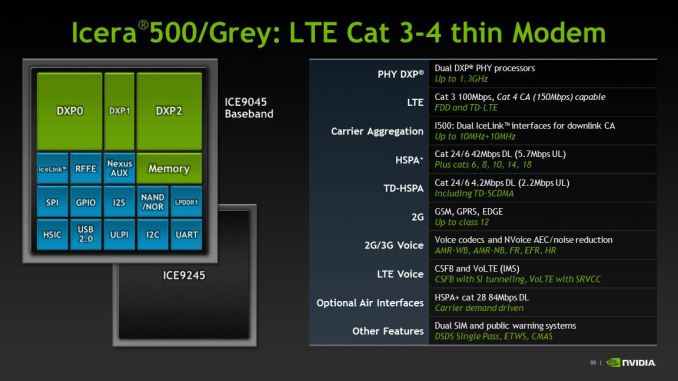NVIDIA Plans To Wind Down Icera Modem Operations In 2016
by Brandon Chester on May 5, 2015 6:25 PM EST
Today NVIDIA announced plans to wind down their Icera modem operations in the latter half of their fiscal 2016. Icera was originally an independent British semiconductor company before they were purchased by NVIDIA in 2011 for $367 million dollars. Their operations primarily focused on software and hardware design for wireless modems, with a strong focus on the software side. Their main product offering was their line of software modems (often shortened to softmodem) for use in cellular hotspots, computers, and mobile devices.
All modems function through a combination of hardware and software. However, at the time of NVIDIA's purchase, Icera's solution was significantly more software based than Qualcomm's. Since Qualcomm was really the only big name in modems at the time, NVIDIA's purchase of Icera made sense in order to ship future Tegra chips without having to rely on external basebands.
Unfortunately, NVIDIA's efforts to ship SoCs with integrated modems in the mobile space haven't worked out as well as planned. While there have been some past design wins for discrete Icera basebands such as in the ZTE Mimosa X, NVIDIA wasn't able to drive adoption of their Tegra 4i SoC with its integrated Icera i500 baseband. As a result, Tegra chips since that time have almost entirely relied on external modems from Qualcomm or other manufacturers, with the discrete i500 only being used a handful of times.
Since then NVIDIA has shifted their focus away from mainstream cell phones and tablets and towards more niche products – the company’s press release specifically calls out gaming, automotive and cloud computing – so the company has not needed an in-house baseband solution as urgently as they once did. Meanwhile for NVIDIA’s immediate future, they expect their existing Icera basebands to meet their needs for the next year (or more), and longer term NVIDIA expects to partner with 3rd party baseband suppliers in a fashion similar to what their customers are already doing today.
NVIDIA's press release states that Icera currently employs around 500 employees, which are mostly located in the United Kingdom and France. No longer having a need for Icera themselves, they are open to a sale of Icera's technology or the company itself. It's unlikely that they'll be able to sell the company for anything near the original $367 million dollars that they paid, as many different companies have begun to offer their own softmodem products in the years since then.
Source: NVIDIA (via SH SOTN)











25 Comments
View All Comments
npaladin2000 - Tuesday, May 5, 2015 - link
It's kinda too bad, then again the baseband they implemented in the Tegra Note, ostensibly Icera-based, really sucked compared to what I'd seen from Qualcomm and what I'm currently seeing from Samsung. It's not just that NVIDIA doesn't need it anymore, it's that it's not competitive anymore.Frenetic Pony - Tuesday, May 5, 2015 - link
Which is why it's being shut down... I've noticed Nvidia is good at GPU's and hype, but so far not much else. Even its Denver cores, which seemed promising at least, have disappeared without word of when they'll come back.D. Lister - Wednesday, May 6, 2015 - link
Their HPC side is doing quite well too. Also :), there's nothing wrong with being good at generating hype - as long as you deliver on that hype consistently enough.testbug00 - Wednesday, May 6, 2015 - link
HPC side of Nvidia involves how many Tegra chips again? Oh, right, ZERO. At least, zero publicly announced. And, I Would assume that means zero total.Samus - Wednesday, May 6, 2015 - link
Yes, Tegra, hands down, sucks when you look at the big picture. Exynos and Snapdragon have more competitive fully integrated offerings, then you've got Intel coming in full-speed with an LTE x86 SoC later this year.Yojimbo - Wednesday, May 6, 2015 - link
NVIDIA did very well with chipsets until that segment dried up for third party designers. Their shield line has done reasonably well (using their Tegra) and they have been successful in automotive (again using Tegra). Was the NVIDIA shield tablet terrible in some way? No it got good reviews and has sold pretty well. They simply can't compete with any device whose primary use demands a cellular modem. Then it's a matter of getting OEMs to use their Tegras in tablets even though Qualcomm is supplying chips for most of the OEMs' lineups and is trying hard to not let NVIDIA get a foot in the door.But most importantly, NVIDIA's major strength doesn't even lie with their GPUs per se, it lies with their software surrounding the GPUs. That's what allows them to be successful in PC graphics (drivers), HPC (CUDA), automotive, and GPU virtualization. So to say that NVIDIA is only good at GPUs doesn't even make sense for their core competencies.
gpumaven - Wednesday, May 6, 2015 - link
what were the problems with the Tegra Note baseband?D. Lister - Wednesday, May 6, 2015 - link
It just seems so ruthless, how the livelihoods of hundreds of people can be written off so casually. I hope those guys received enough severance to keep themselves comfortable until they find a new job.jmunjr - Wednesday, May 6, 2015 - link
Really? Would it be ruthless on their part if they quit? Of course not. The fact is Nvidia no longer could afford to pay them a lot of money for pretty much no value in return. They're lucky they've been getting paid at all. I find it hilarious employees need severances to survive. I've always had enough saved as an emergency to last about six months of bills. In my (and Nvida's) field, if one can't get a job in six months, they should be worried about lot more than a severance.D. Lister - Wednesday, May 6, 2015 - link
Well now, your exponentially manlier outlook of temporary unemployment has made the futility of common courtesy on the internet glaringly obvious. Oh wait, it hasn't, because it isn't.